I bought a kettle recently. Well, I’ve bought a few! And while learning to use my new kettle, I
I cut out the boring stuff that’s added together with the important information – that most of us tend to miss because it’s buried in plug safety guidelines! And I thought I’d share my findings here.
New Kettle Instructions. When you buy a kettle, you should get acquainted with its features first. Then go through the safety guidelines and follow them. Before use, always clean your new kettle. Afterward, you can follow the steps mentioned below and start using your kettle.
This, of course, assumes you are aware of the safety aspects of electricity and water and the dangers of heat and faulty plug sockets, etc. Ok, so let me walk you through the important things to get your kettle ready.
Types of Kettles
There are two main types of kettles called stovetop kettles and electric kettles.
Modern stovetop kettles are made up of stainless steel. But there are ones made out of materials like copper, cast iron, glass, and ceramic.
Electric kettles are the most popular as they boil water fast and provide a more modern look and modern safety features.
But be careful when buying electric kettles as they may contain BPA. BPA is a plastic toxin that could seep into the water when water is boiling and cause a bad taste – more on that shortly.
Main Features of a Kettle
As you can see in the diagram, every kettle has a spout, lid, handle and body.
In most stovetop kettles you’ll find a whistle that will blow when the water is boiling. A removable lid for filling, a spout and some form of lifting handle.
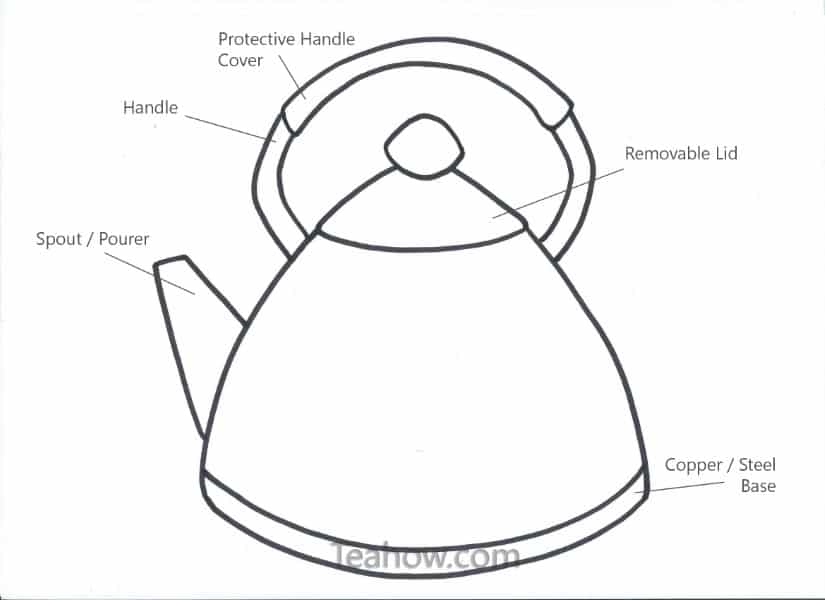
Electric kettles are slightly different from stovetop kettles. They’re either corded or cordless. If you want to use your electric kettle as a jug simultaneously then go for a cordless one. Apart from the power button, there’s almost always a water gauge that shows you the amount of water in the kettle.
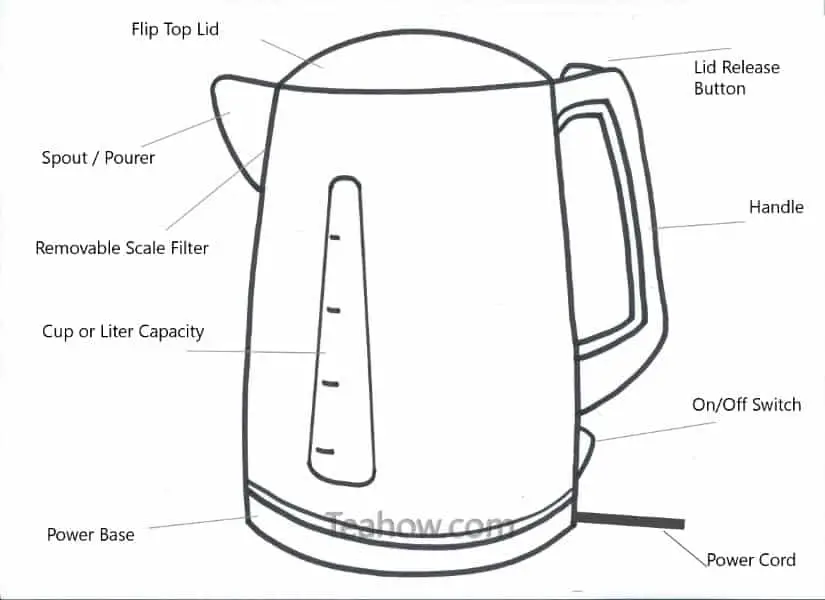
How a Kettle Boils Water
Boiling water in a stovetop kettle is simple. When a kettle filled with water is kept on the stove, the base heats up.
The heat is transferred through the base to the water. As water increases its temperature, pressure starts to build in the enclosed space. When the pressure reaches a maximum, the whistle on top goes off indicating that water is boiled.
In an electric kettle, the process is slightly different. Electric kettles usually have a heating element near the base, or with more modern kettles it’s built into the base. So, when you plug in your kettle, electric current flows through the base. This starts to heat the heating element.
This heat is in turn transferred into the water, bringing it up to its boiling point. Once water is boiled, the inbuilt thermostat automatically switches off the kettle.
Cleaning Your New Kettle
You will see that your new kettle has stickers and tags on it. First, remove all of them.
Most kettles are coated with chemicals by the manufacturer to prevent them from rusting. Also, when kettles are kept in shops or storage houses, they collect dust in them. This is the key part that trips a lot of people up when using it for the first time.
To get rid of these chemicals and dust, clean the kettle thoroughly with dishwashing soap or liquid.
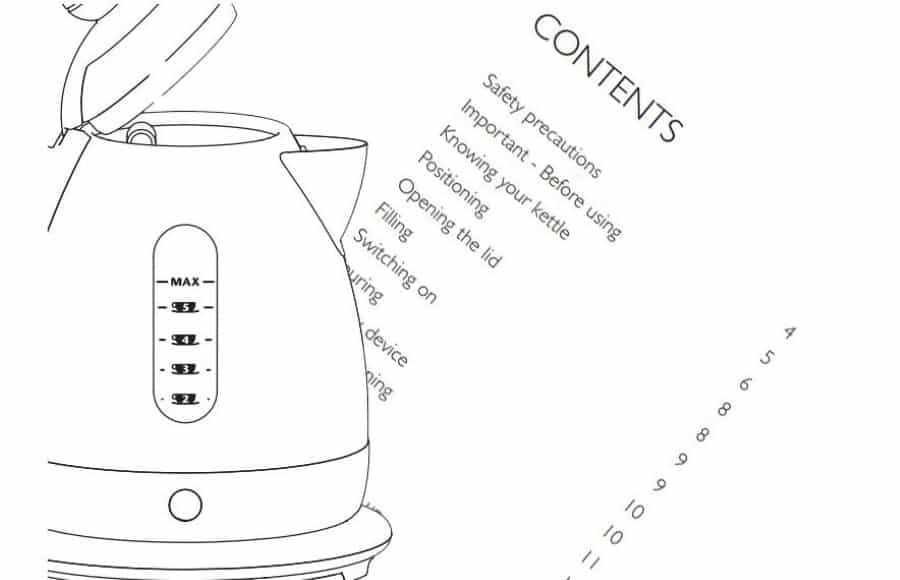
How to Use Your New Kettle?
Step 1: Clean the kettle thoroughly.
The first step is to clean the kettle properly as mentioned above. If you have an electric kettle, DO NOT wash the power cable or any other
Step 2: Fill the kettle completely with water and boil.
Those of you who have a stovetop kettle should fill water up to the point where the spout starts from inside the kettle. Any more and you risk the water bubbling out of the spout whilst boiling.
If you have an electric kettle, fill the kettle up to the point which indicates the maximum water level. That level is there for a safety reason, so it’s best not to push it beyond that.
Also, when you keep the kettle on the stove, keep the base of the kettle directly above the burner or hot plate. You will hear a whistling noise once water is boiled and that’s your cue to turn off the stove.
But your electric kettle would work only if you have correctly placed it on the power base and switched ON the power button. It will automatically switch off once water is boiled.
Step 3: Discard the water.
You cannot drink the boiled water after the first boil as chemicals that have been coated inside the kettle are mixed with water.
When you discard water after the first boil, you might notice that the color of the kettle base has changed. Especially in copper stovetop kettles. Do not be alarmed, it’s just the chemical coming off. Wipe the base with a clean piece of cloth before refilling.
Step 4: Repeat steps 2 and 3 for 3 or 4 times.
In most kettles, chemicals that cause a bad taste and smell in boiled water do not go after the first boil. So, repeat the process of boiling and discarding water several times until your kettle is fully cleaned and free of chemicals.
Step 5: Start using the kettle.
You can now use the kettle to boil water for consumption.
Now that you have your new kettle all shiny and ready to use. It’s a good time to make full use of it and make some great tea. Why not get my fabulous tea sommelier course.
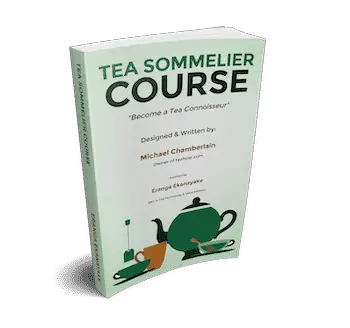
Take the fast track and become a tea connoisseur
Whether for enjoyment or considering a career as a tea sommelier. This course has everything you need to enhance your tea knowledge and tea-tasting skills.
This course keeps it simple with step-by-step tea tasting and easy reference guides
For pleasure, or as a precursor to a career in the tea industry. Find out what tea sommelier actually does, their career paths, and what they earn.

Find out more about the Teahow Tea Sommelier Course!
Did you know?
It can actually be bad to use boiled water to make tea?
You can find out more by reading my article Is it Bad to Boil Tea?
Safety Guidelines
For stovetop kettles:
- Keep the base of the kettle directly above the burner or hot plate.
- Do not allow flames to come out from either side of the kettle as it might melt the handle or spout.
- Be careful when picking up the handle as it’s likely to be hot, use a cloth or tea towel if necessary
For electric kettles:
- Do not wash the power cable.
- Before you plug in the kettle, ensure that the base is dry.
- Check whether the plug is working and whether you have the correct pinhole to plug it in.
- Place the kettle correctly on the power base.
Recommended BPA Free Kettles
Most electric kettles have plastic somewhere in them. You should select a kettle having a minimal amount of plastic contact with water. I came across the 2 best BPA-free kettles that had good reviews and ratings on Amazon, and then I’ve added details about the BPA kettle I use.
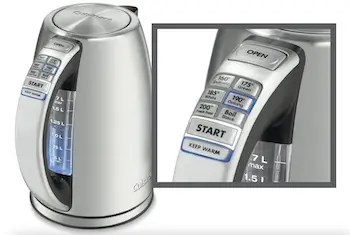
My favorite temperature-controlled kettle
My all-time favorite kettle for brewing my tea is my temperature-controlled kettle AND it’s BPA-free too. Mine is from the UK on amazon, an equivalent model for the US market though is the kettle shown here.
It has the same features as the one I have. This is ideal for tea drinkers who like to get the temperature just right for Oolong, black white, green tea, etc. My UK version of this kettle is here
If you find that your kettle is smelling bad, has a plastic smell when boiling or a sort of TCP smell, then it could be down to the plastic. As well as the kettles above, I have an article about the bad smell and taste from your kettle, which covers this in more detail.
General Maintenance
If you want to use your kettle for a long time, clean it regularly. When you clean the outer surface always use a piece of cloth or sponge.
Cleaning the inner surface can be tricky, especially if there is limescale. The easiest way to remove limescale is to fill half of the kettle with water and the other half with vinegar, leave for 1 or 2 hours and rinse thoroughly.
Also, do not plug in or heat an empty kettle, this will only serve to damage the elements.
Do not store water in the kettle after boiling as it causes limescale to build up faster, damaging the kettle and left water can stagnate over time.
Maintenance Differences for Common Kettles
Stovetop kettles have to be filled up to a certain level prior to each boil. But you should try to only boil the required amount of water in electric kettles. This will increase the durability of the heating element.
When you want half boiled water, you can simply turn off the stove without waiting until the whistle sounds while using stovetop kettles. But if you do this with an electric kettle, it will damage the thermostat.
For tea making, there’s a more natural way to boil water to the right temperature, you can use the traditional Fish Eye Method!
Troubleshooting Your New Kettle
If your kettle won’t switch on, check whether you have correctly placed it on the power base. Also, check whether you have an uninterrupted power supply and ensure that the base of the kettle is dry.
Overfilling is another problem that you might face. When filling your stovetop kettle, do not fill it to the brim. This is to avoid water spilling out of the spout while boiling
For the electric kettle, only fill what you need to use, with a little extra, and only fill water up to the maximum water level marked on the side. Overfilling is bad for the kettle as it will overwork the elements, risk spilling out through the spout, and waste energy as well.
When using your new kettle, you should avoid boiling it dry at all costs. Boiling dry means heating the kettle without a sufficient amount of water or with no water at all. If you do this, the heating element will get severely damaged, reducing the life span of your kettle.
Conclusion
I hope you found this article useful to know how to use your new kettle. If you thought this was helpful then check out my Tea Sommelier Course. Or head over to my tea-ware page for some great specially curated gifts and tools to use
Some of you might find that your new kettle smells bad when boiled. Check out my article here to find why.
Here’s another method by which you can clean your new kettle…
RELATED QUESTIONS:
How Often Should a Kettle Be Descaled? If you boil hard water in your kettle, descale it at least once a month. If not, descale it once in three months.
Can You Use a New Kettle Straight Away? No. You should clean the kettle first. Then, boil water and discard for 3 or 4 times before you start to use your new kettle.
Is It Ok to Leave Water in a Kettle? No. not for more than a few hours. When water is left in a kettle, it speeds up the limescale forming process. Also, water left in a kettle long enough will begin to stagnate as well as being prone to dust particles entering through the spout.
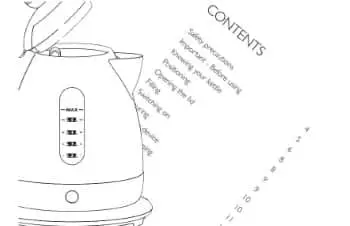
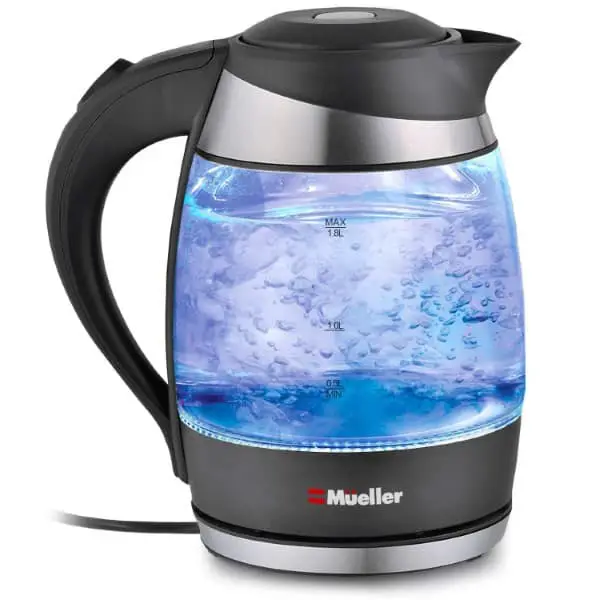
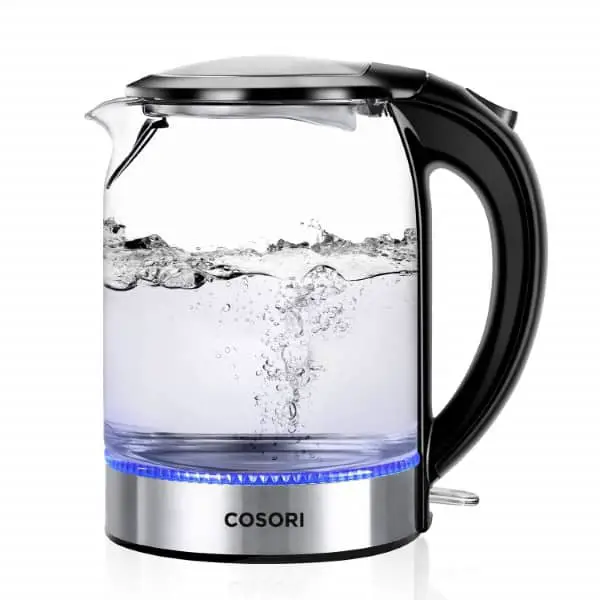
Does a stove top kettle take longer to boil first time of use ?
My le creuset took 10 minutes to boil one litre- seems a long time
Thank you so much for such an informative article.
I’d say go for it 🙂
Can I add natural ingredients directly in the kettle: ie; sage leaves, lemons, soursop leaves?
Many thanks for your helpful posts. I have just bought a Bosch electric kettle but haven’t got any vinegar so I think, judging from your article I’ll have to wait until I can get some before I can use it.
Thank you for the comment, really glad to hear it 🙂
We found the best electric kettles, including retro-style electric tea kettles from you.
Thank you Johnny, I’m glad you found it helpful.
Great article on preparing the kettle for first use!
Thanks!
Johnny